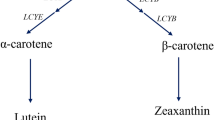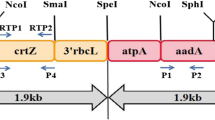Abstract
Chlamydomonas reinhardtii is a well-established microalgal model species with a shorter doubling time, which is a promising natural source for the efficient production of high-value carotenoids. In the microalgal carotenoid biosynthetic pathway, lycopene is converted either into β-carotene by lycopene β-cyclase or into α-carotene by lycopene ε-cyclase (LCYE) and lycopene β-cyclase. In this study, we overexpressed the LCYE gene in C. reinhardtii to estimate its effect on lycopene metabolism and lutein production. Chlamydomonas transformants (CrLCYE#L1, #L5, and #L6) produced significantly increased amounts of lutein per culture (up to 2.6-fold) without a decrease in cell yields. Likewise, the expression levels of LCYE gene in transformants showed a significant increase compared with that of the wild-type strain. These results suggest that LCYE overexpression enhances the conversion of lycopene to α-carotene, which in turn improves lutein productivity. Interestingly, their β-carotene productivity appeared to increase slightly rather than decrease. Considering that the inhibition of the lycopene cyclization steps often induces higher expression in genes upstream of metabolic branches, this result implies that the redirection from β-carotene to α-carotene by LCYE overexpression might also enhance upstream gene expression, thereby leading to auxiliary β-carotene production.





Similar content being viewed by others
Data Availability
Not applicable
Code Availability
Not applicable
References
Saini, R. K., Nile, S. H., & Park, S. W. (2015). Carotenoids from fruits and vegetables: Chemistry, analysis, occurrence, bioavailability and biological activities. Food Research International, 76(Pt 3), 735–750. https://doi.org/10.1016/j.foodres.2015.07.047.
De Jesus Raposo, M. F., De Morais, A. M. M. B., & De Morais, R. M. S. C. (2015). Carotenoids from marine microalgae: A valuable natural source for the prevention of chronic diseases. Marine Drugs, 13(8), 5128–5155. https://doi.org/10.3390/md13085128.
Koller, M., Muhr, A., & Braunegg, G. (2014). Microalgae as versatile cellular factories for valued products. Algal Research, 6(PA), 52–63. https://doi.org/10.1016/j.algal.2014.09.002.
Cezare-Gomes, E. A., Mejia-da-Silva, L. d. C., Pérez-Mora, L. S., Matsudo, M. C., Ferreira-Camargo, L. S., Singh, A. K., & de Carvalho, J. C. M. (2019). Potential of microalgae carotenoids for industrial application. Applied Biochemistry and Biotechnology, 188(3), 602–634. https://doi.org/10.1007/s12010-018-02945-4.
Lohr, M., Im, C. S., & Grossman, A. R. (2005). Genome-based examination of chlorophyll and carotenoid biosynthesis in Chlamydomonas reinhardtii. Plant Physiology, 138(1), 490–515. https://doi.org/10.1104/pp.104.056069.
Lohr, M., Schwender, J., & Polle, J. E. W. (2012). Isoprenoid biosynthesis in eukaryotic phototrophs: A spotlight on algae. Plant Science, 185–186, 9–22. https://doi.org/10.1016/j.plantsci.2011.07.018.
Christaki, E., Bonos, E., Giannenas, I., & Florou-Paneri, P. (2013). Functional properties of carotenoids originating from algae. Journal of the Science of Food and Agriculture, 93(1), 5–11. https://doi.org/10.1002/jsfa.5902.
Scaife, M. A., Nguyen, G. T. D. T., Rico, J., Lambert, D., Helliwell, K. E., & Smith, A. G. (2015). Establishing Chlamydomonas reinhardtii as an industrial biotechnology host. The Plant Journal, 82(3), 532–546. https://doi.org/10.1111/tpj.12781.
Cordero, B. F., Couso, I., León, R., Rodríguez, H., & Vargas, M. Á. (2011). Enhancement of carotenoids biosynthesis in Chlamydomonas reinhardtii by nuclear transformation using a phytoene synthase gene isolated from Chlorella zofingiensis. Applied Microbiology and Biotechnology, 91(2), 341–351. https://doi.org/10.1007/s00253-011-3262-y.
Couso, I., Vila, M., Rodriguez, H., Vargas, M. A., & León, R. (2011). Overexpression of an exogenous phytoene synthase gene in the unicellular alga Chlamydomonas reinhardtii leads to an increase in the content of carotenoids. Biotechnology Progress, 27(1), 54–60. https://doi.org/10.1002/btpr.527.
Liu, J., Gerken, H., Huang, J., & Chen, F. (2013). Engineering of an endogenous phytoene desaturase gene as a dominant selectable marker for Chlamydomonas reinhardtii transformation and enhanced biosynthesis of carotenoids. Process Biochemistry, 48(5), 788–795. https://doi.org/10.1016/j.procbio.2013.04.020.
Morikawa, T., Uraguchi, Y., Sanda, S., Nakagawa, S., & Sawayama, S. (2018). Overexpression of DnaJ-like chaperone enhances carotenoid synthesis in Chlamydomonas reinhardtii. Applied Biochemistry and Biotechnology, 184(1), 80–91. https://doi.org/10.1007/s12010-017-2521-5.
Kumari, S., Vira, C., Lali, A. M., & Prakash, G. (2020). Heterologous expression of a mutant Orange gene from Brassica oleracea increases carotenoids and induces phenotypic changes in the microalga Chlamydomonas reinhardtii. Algal Research, 47, 101871. https://doi.org/10.1016/j.algal.2020.101871.
Perozeni, F., Cazzaniga, S., Baier, T., Zanoni, F., Zoccatelli, G., Lauersen, K. J., Wobbe, L., & Ballottari, M. (2020). Turning a green alga red: engineering astaxanthin biosynthesis by intragenic pseudogene revival in Chlamydomonas reinhardtii. Plant Biotechnology Journal, 18(10), 2053–2067. https://doi.org/10.1111/pbi.13364.
Tan, C.-P., Zhao, F.-Q., Su, Z.-L., Liang, C.-W., & Qin, S. (2007). Expression of β-carotene hydroxylase gene (crtR-B) from the green alga Haematococcus pluvialis in chloroplasts of Chlamydomonas reinhardtii. Journal of Applied Phycology, 19(4), 347–355. https://doi.org/10.1007/s10811-006-9141-8.
Kindle, K. L. (1990). High-frequency nuclear transformation of Chlamydomonas reinhardtii. Proceedings of the National Academy of Sciences of the United States of America, 87(3), 1228–1232. https://doi.org/10.1073/pnas.87.3.1228.
Packeiser, H., Lim, C., Balagurunathan, B., Wu, J., & Zhao, H. (2013). An extremely simple and effective colony PCR procedure for bacteria, yeasts, and microalgae. Applied Biochemistry and Biotechnology, 169(2), 695–700. https://doi.org/10.1007/s12010-012-0043-8.
Kubo, Y., Shiroi, M., Higashine, T., Mori, Y., Morimoto, D., Nakagawa, S., & Sawayama, S. (2020). Enhanced production of astaxanthin without decrease of DHA content in Aurantiochytrium limacinum by overexpressing multifunctional carotenoid synthase gene. Applied Biochemistry and Biotechnology, 193(1), 52–64. https://doi.org/10.1007/s12010-020-03403-w.
Moellering, E. R., & Benning, C. (2010). RNA interference silencing of a major lipid droplet protein affects lipid droplet size in Chlamydomonas reinhardtii. Eukaryotic Cell, 9(1), 97–106. https://doi.org/10.1128/EC.00203-09.
Pogson, B., McDonald, K. A., Truong, M., Britton, G., & DellaPenna, D. (1996). Arabidopsis carotenoid mutants demonstrate that lutein is not essential for photosynthesis in higher plants. The Plant Cell, 8(9), 1627–1639. https://doi.org/10.1105/tpc.8.9.1627.
Yu, B., Lydiate, D. J., Young, L. W., Schäfer, U. A., & Hannoufa, A. (2008). Enhancing the carotenoid content of Brassica napus seeds by downregulating lycopene epsilon cyclase. Transgenic Research, 17(4), 573–585. https://doi.org/10.1007/s11248-007-9131-x.
Diretto, G., Tavazza, R., Welsch, R., Pizzichini, D., Mourgues, F., Papacchioli, V., Beyer, P., & Giuliano, G. (2006). Metabolic engineering of potato tuber carotenoids through tuber-specific silencing of lycopene epsilon cyclase. BMC Plant Biology, 6(1), 13. https://doi.org/10.1186/1471-2229-6-13.
Harjes, C. E., Rocheford, T. R., Bai, L., Brutnell, T. P., Kandianis, C. B., Sowinski, S. G., et al. (2008). Natural genetic variation in lycopene epsilon cyclase tapped for Maize biofortification. Science, 319(5861), 330–333. https://doi.org/10.1126/science.1150255.
Farré, G., Sanahuja, G., Naqvi, S., Bai, C., Capell, T., Zhu, C., & Christou, P. (2010). Travel advice on the road to carotenoids in plants. Plant Science, 179(1–2), 28–48. https://doi.org/10.1016/j.plantsci.2010.03.009.
Osmond, C. B., Foyer, C. H., Bock, G., Pogson, B. J., & Rissler, H. M. (2000). Genetic manipulation of carotenoid biosynthesis and photoprotection. Philosophical Transactions of the Royal Society of London. Series B: Biological Sciences, 355(1402), 1395–1403. https://doi.org/10.1098/rstb.2000.0701.
Liang, M. H., Hao, Y. F., Li, Y. M., Liang, Y. J., & Jiang, J. G. (2016). Inhibiting lycopene cyclases to accumulate lycopene in high β-carotene-accumulating Dunaliella bardawil. Food and Bioprocess Technology, 9(6), 1002–1009. https://doi.org/10.1007/s11947-016-1681-6.
Fazeli, M. R., Tofighi, H., Madadkar-Sobhani, A., Shahverdi, A. R., Nejad-Sattari, T., Sako, M., & Jamalifar, H. (2009). Nicotine inhibition of lycopene cyclase enhances accumulation of carotenoid intermediates by Dunaliella salina CCAP 19/18. European Journal of Phycology, 44(2), 215–220. https://doi.org/10.1080/09670260802578526.
Acknowledgements
We thank Prof. Tatsuya Sugawara and Assistant Prof. Yuki Manabe for the constructive comments and discussion.
Funding
This work was partly supported by the Sun Chlorella Corp. (Kyoto, Japan).
Author information
Authors and Affiliations
Contributions
ST conducted experiments. DM analyzed data and wrote the manuscript. KO partly contributed figure preparation. TK, TH, and YM partly contributed establishment of experimental methods. SN and SS conceived and designed research. All authors read and approved the manuscript.
Corresponding author
Ethics declarations
Ethics Approval
This article does not contain any studies with human participants by any of the authors.
Consent to Participate
Not applicable
Consent for Publication
All authors consent to the submission and publication of this manuscript in Applied Microbiology and Biotechnology.
Competing Interests
The authors declare no competing interests.
Additional information
Publisher’s Note
Springer Nature remains neutral with regard to jurisdictional claims in published maps and institutional affiliations.
Supplementary Information
ESM 1
(DOCX 959 kb)
Rights and permissions
About this article
Cite this article
Tokunaga, S., Morimoto, D., Koyama, T. et al. Enhanced Lutein Production in Chlamydomonas reinhardtii by Overexpression of the Lycopene Epsilon Cyclase Gene. Appl Biochem Biotechnol 193, 1967–1978 (2021). https://doi.org/10.1007/s12010-021-03524-w
Received:
Accepted:
Published:
Issue Date:
DOI: https://doi.org/10.1007/s12010-021-03524-w




